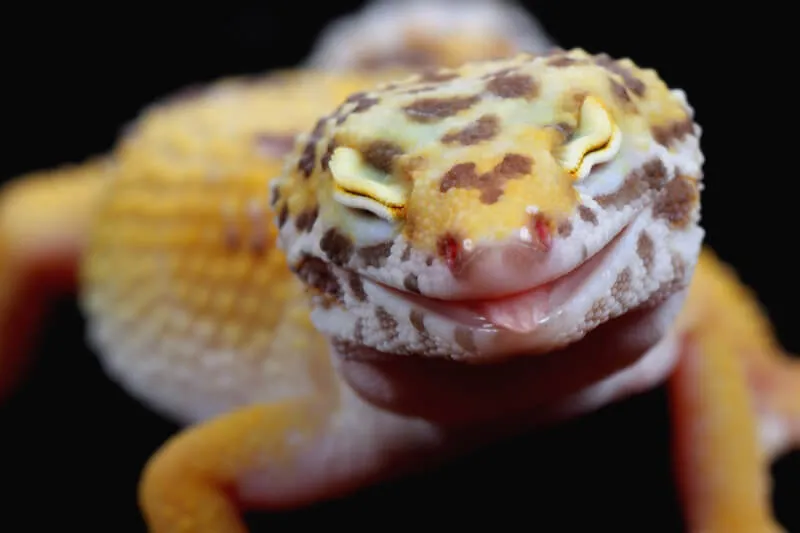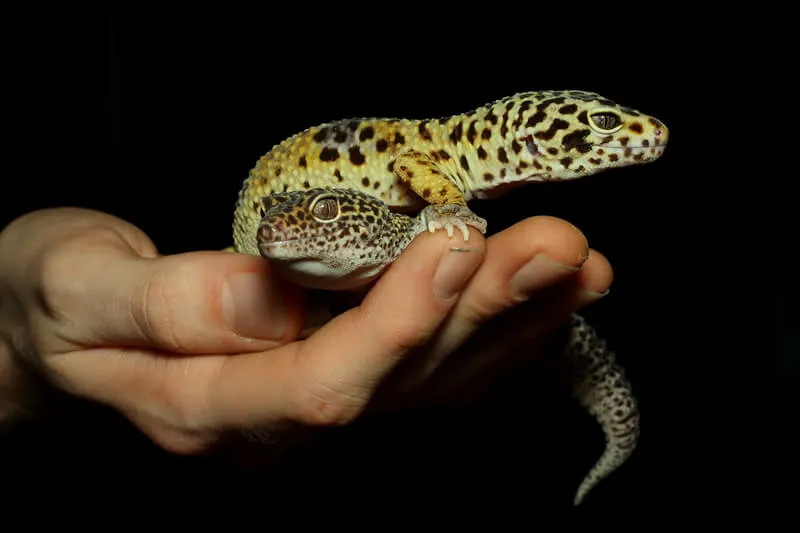
Leopard geckos come from a quite dry, desert-like environment, so many of us associate them with sand. However, if you notice your Leopard Gecko eating sand, you may wonder what’s going on and if your Leopard Gecko may be in danger from eating it.
Leopard Geckos most commonly eat sand because of a nutrient deficiency. Most of the time, this behavior is caused by a calcium deficiency. However, they may also eat sand when they ingest it accidentally when they are feeding or exploring their environment or because they are very hungry.
Here’s what you need to know about why your Leopard Gecko might be eating sand, as well as some solutions for this potential problem.
Table of Contents
Why is my Leopard Gecko Eating Sand?
Leopard Geckos Eating Sand Because of a Nutrient Deficiency
If your Leopard Gecko isn’t getting sufficient nutrients from their diet, they may attempt to get those nutrients from the sand in their enclosure. Very often, leopard geckos need more minerals than they can get from the average insect diet in captivity.
They need additional calcium, vitamin D3, and other nutrients than what typically naturally occurs in an insect diet provided by humans. Since sand often has calcium in it, it makes sense that Leopard Geckos would eat (even moss) sand if they aren’t getting enough calcium.
If you are not currently supplementing your Leopard Gecko’s diet with nutrients and find them eating sand, providing more nutrients will solve the problem in most cases.
Actually, calcium deficiency is the number one reason why leopard geckos eat sand or any other substrate. It doesn’t matter if it is sand, soil, or any other form of natural substrate.
There are two ways to supplement your Leopard Gecko’s diet to make sure that your leo stops eating sand and gets all the vitamins and minerals it needs:
Gut load insects
One of the easiest ways to ensure that your Leopard Gecko is getting a balanced diet is to ensure that the crickets are eating a nutritious diet.
A commercial cricket diet like this one here provides nutrients, water, and minerals like calcium. This provides your crickets with everything that they need in one easy-to-feed product.

Dust insects
Dusting feeder insects with a vitamin supplement is a good option for people who do not keep feeder insects long enough to gut load them.
However, a calcium supplement should almost always be used to dust the feeder insects. Simply put a little bit of this calcium powder in a container with the crickets, mealworms, etc., and shake them gently around to coat them before feeding them to your Leopard Gecko.
Note: For optimal nutrition for your Leopard Gecko, you can also feed your crickets a wholesome diet of fruits, vegetables, and proteins in addition to gut loading with a commercial cricket diet or dusting. Read our leopard gecko calcium guide to learn more!
Accidental Ingestion of Sand and How to Avoid it
Leopard geckos may scoop up sand along with their crickets when they feed. Since Leopard Geckos feed by either using their sticky tongue to make contact with insects or scooping insects up in their jaws, there are a lot of opportunities for them to ingest sand accidentally.
Usually, the amounts of substrate that are ingested accidentally are very small and don’t cause any trouble. However, if you are extremely worried, there are a few options available:
Use a sand alternative
Using alternative bedding may be the easiest way to completely eliminate the risk of your Leopard Gecko ingesting sand. We’ll go over some great sand alternatives later on.
Feed in a separate container
You can take your Leopard Gecko out of their enclosure and feed them in a container where they can eat without fear of ingesting sand. This has the added benefit of ensuring that no insects are left loose in the enclosure with the Leopard Gecko.
Provide a feeding area in the enclosure
This technique only works with insects that are not as mobile or if you are hand-feeding.
Providing an area with slick sides that insects can’t climb out of will enable your Leopard Gecko to eat most of their prey in an area where they won’t ingest sand.
Here’s a Leopard Gecko happily eating mealworms from a bowl:
Hunger Driven Sand Eating in Leopard Geckos
Leopard geckos that are very hungry may try to eat just about anything to fill their stomachs. If your Leopard Gecko doesn’t have a fat tail and always seems ravenous at feeding time, they may not be eating enough to remain nourished.
Most adult Leopard Geckos should eat around six or seven large crickets or mealworms two or three times a week.
Leopard geckos typically stop eating when they’re full, so by gauging your Leopard Gecko’s behavior, you can get a sense of whether they are eating enough. Read our leo diet guide to learn more!
Note: If your Leopard Gecko never seems satisfied with the amount of
food they get, an intestinal parasite or another medical issue may be at fault, so have your vet check them out.
Sand ingestion While Leopard Geckos Explore Their Environment
Leopard Geckos use their tongues to explore their environment and “smell” their surroundings. You will likely notice that your Leopard Gecko briefly licks just about everything in their enclosure and even your hands when you are holding them.
Because the tongue is sticky, when they try to explore a sandy environment, they will inevitably ingest some sand.
How to Tell if Your Leopard Gecko is Impacted From Eating Sand
The primary risk to a Leopard Gecko in eating sand is that they will become impacted. Here are a few clear indications that your Leopard Gecko has become impacted:
- Reduced appetite or refusing to eat at all
- Reduced activity and lethargy
- Visible sand in bowel movements
- Swelling in the abdomen and a belly that is hard to the touch
- Vent prolapse
In minor cases, you may be able to treat impaction yourself by eliminating the source of impaction and giving your Leopard Gecko warm baths twice a day.
The water needs to be just deep enough to cover your Leopard Gecko’s hips. You can also very gently massage your Leopard Gecko’s belly to help get things moving. Administering a drop of olive oil or mineral oil can also be helpful.
Note: Young Leopard Geckos are more prone to impaction than older geckos, but any gecko can be affected.
Alternatives to Sand as Your Leopard Gecko’s Substrate
There is a heated debate in the Leopard Gecko community about whether or not to use sand as a substrate. Many people have been using sand for their Leopard Geckos for many years without any trouble at all and don’t see the problem.
Other people find that their Leopard Gecko’s become impacted and even die as a result of a sand substrate. To play it safe, many people choose not to use sand in a Leopard Gecko’s enclosure.
Other people choose to use only small areas of sand. Here are a few great sand alternatives:
Reptile carpet
Reptile carpet is made specifically for use with reptiles. The material won’t irritate your Leopard Gecko’s skin and it can’t be ingested. It is fairly easy to clean by removing fecal matter daily and washing several times a month.

Newspaper
This is one of the most affordable options, but it isn’t particularly attractive and must be replaced daily to avoid bacterial growth.
Paper towels
Paper towels are easy to replace when you see areas that have become soiled, and they provide a consistent color to view your Leopard Gecko against, although they are not the most natural or attractive option.
Slate or stone
Slate or stone looks natural, and it can be a great option for bioactive enclosures since it can cover soil and allow plants to grow and insects to multiply without an impaction risk for your gecko. It can be spot cleaned and taken out to be washed as needed.
Tile
Tile works in the same ways as slate or stone, but many people find it more convenient to use since it can thoroughly cover the bottom of the enclosure, and there is an almost unlimited variety of colors to choose from.
Shelf liner
Shelf liner can be a simple solution to cut to size and fit in your Leopard Gecko’s terrarium. An adhesive liner should never be used because of the risk of insects being trapped underneath or Leopard Geckos being stuck to it when they try to dig.
What about Eco Earth as an Alternative Leopard Gecko Substrate?
Eco Earth, made by Zoo Med, is designed to be a safe substrate for a wide variety of reptiles and amphibians. It is made of compressed coconut fiber.
Because Eco Earth (see here) has particles that are small enough to be ingested, there is some risk of it causing impaction in the same way that sand does, but many people find it to be a good option to use in the humid area of your Leopard Gecko’s enclosure since it tends to hold moisture and it’s great for burrowing.
If your Leopard Gecko loves to dig, and you are looking for a safer alternative than sand, Eco Earth may be the right choice for you.
- Enchi Ball Python: A Unique and Stunning Morph of Python regius - March 27, 2025
- Emerald Tree Monitor: The Enigmatic Green Guardian of the Rainforest - March 26, 2025
- The Egyptian Cobra (Naja haje): A Fascinating Serpent - March 25, 2025
